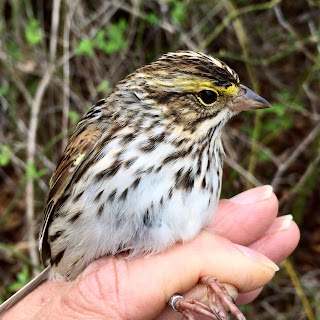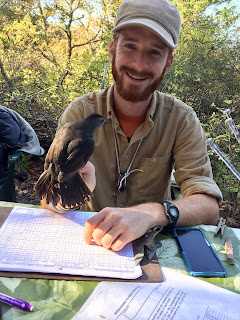A typical spring day on Cape Cod consists of cold, wind, rain and this year was no exception. May 4th was cloudy, overcast, with occasional spitting light rain and while we only had 19 birds, a second year (SY) Savannah Sparrow was a nice catch.
This bird was aged as SY due to a molt limit seen at the alula covert(darker brown color), abraded primary coverts and a molt limit in the tertials, secondaries 8,9 were replaced but s7 was retained.
A very common bird but one we hardly ever get in our nets was a Mourning Dove captured on May 6th and then we captured two more! They seemed to be all over the island this year. The top photo is a female and the bottom one is a juvenile bird.
May 9th was our busiest spring day as nice SW winds brought in 115 birds of 18 species, a big day for us during spring monitoring season. Some of the birds were migrants just passing through including a Least Flycatcher (couldn't get a good picture), an after second year (ASY) male Black-throated Blue Warbler,
a SY male Myrtle Warbler,
and a SY female Orange-crowned Warbler. This was our second spring season in a row capturing this species, normally only seen on Wing Island in the fall.
This day also brought in our first of year (FOY) breeders: an ASY male Prairie Warbler,
an ASY male Common Yellowthroat,
and an ASY male Yellow Warbler.
We spent numerous days in the spring banding in the Punkhorn too. Some notable captures there included a very old Black-and-White Warbler on 10 May at least in his 10th year first banded as an ASY in 2008. The oldest known BAWW is 11 years 3 months.
The Alder Flycatcher from last year came back singing in the same spot and was recaptured in the same net as last year.
Another nice bird in the Punkhorn is Black-billed Cuckoo. We hear numerous cuckoos vocalizing from different areas during net runs.
This year I offered a beginner banding class from 16-20 May with fellow NABC Trainer Anthony Hill. We had 5 participants and had a successful and fun week! All the students were eager to learn and participate. Some pics from our week:
Jane Wing (left) and Lucy Wightman (sitting)
Stefanie Paventy and Anthony Hill
Luckily we had a nice variety of birds that week to teach some ageing and sexing. Some of the highlights for the week were:
ASY male Magnolia Warbler
SY male Northern Parula
SY male American Redstart
and a SY Northern Waterthrush.
We also banded two birds we rarely get that week, an ASY Wood Thrush
and a SY male Bay-breasted Warbler.
On July 20th I had the privilege of banding a Barn Owl and a female American Kestrel. Both of the birds were ready to be released from the Wildlife Center in Barnstable.
I normally start fall banding monitoring on August 1st but August was such a hot month with many days just too hot and humid to safely carry out banding operations. The majority of our nets are quite exposed to the sun due to the low shrubbery so I didn't get out many days. By September we were in full swing and I was so fortunate to have a volunteer intern again this year, Bradford Bower. I taught him as much as I could and he was great at extracting, banding, and ageing birds. He was with me every day I went out. You'll be greatly missed next year, Bradford!
Our first of season Yellow-bellied Flycatcher was captured on 2 September and then we couldn't band for 5 days due to the wind effects of Hurricane Hermine.
We also captured a young male flicker in the process of molting his primaries. His eating habits changed midstream when he began to focus on fruits from invasive honeysuckles that contain
rhodoxanthin pigment producing more of the red coloration in the feather shafts.
Early September brought some other migrants; a HY male Black-throated Green Warbler on the 7th,
a Yellow-breasted Chat on the 8th
and we banded two Connecticut Warblers this fall, a real treat.
Ruby-crowned Kinglets (58 banded) arrrived late September
along with Blue-headed Vireos (10 banded).
Majestic Red-bellied Woodpeckers are difficult to capture due to the smaller size of our mist nets.We did however, manage to band 4 this fall! Previous captures included 2 in 2008, 1 in 2013, and 1 last year.
The habitat on Wing Island isn't the best for thrushes, but we were fortunate to capture at least one Swainson's Thrush on Oct 6th. The bird was aged as HY due to the retained greater coverts. The buff triangular-shaped edging is indicative of a juvenal feather.

Another bird we only band once or twice a year was an Indigo Bunting on the 7th, a rather drab HY female.
We had our largest number of species for the fall on Oct 12th, 26 in all. Some of the birds on this list were American Redstart, Blackpoll Warbler, Western Palm Warbler, Yellow-breasted Chat, Blue-headed Vireo, Red-eyed Vireo, Lincoln Sparrow, and two new species for the fall, a Brown Thrasher, aged as HY due to a molt limit in the tertials
and a HY Purple Finch of unknown sex. While this bird may look like a female, some young males may not develop male plumage until the following year.
We anticipated being stuck on the island on the 18th with a forecast of a King tide. And what a tide it was! Gretchen, Bradford, and I went down to the boardwalk to see if we could make it over, but nope we had to wait another hour at least. Good thing I closed up the south side nets early!



We banded 11 Orange-crowned Warblers during the fall season, a record number for our station
and captured our first of 5 Marsh Wrens on the 19th. I love the combination of brown, black, and white markings of this species.

Most HY wrens go through an incomplete molt, meaning they can molt some of their primary feathers and some of their secondary feathers. We use this criteria for ageing and the retained middle primaries compared to the darker, fresher inner and outer primaries is obvious in this bird.
We banded a diminutive Winter Wren, our one and only, on the 24th
and a very late Prairie Warbler on the 26th.
Our biggest fall day was 27 Oct with 206 birds netted including our first of fall HY Eastern White-crowned Sparrow.
On the 30th I captured a very dark looking Eastern Phoebe, one of the darkest plumaged bird I have ever seen on a HY bird. The intensity of the orange in the mouth was quite striking too for this species.



Banding typically slows down for us in November but this year was quite busy. We had numerous 100+ bird days with other days numbering in the 70's and 80's. Our best birds for this month were American Tree Sparrow, with a bicolored bill and central breast spot,
a beautiful Fox Sparrow,
and a HY male Sharp-shinned Hawk, all on the 8th.
It was a quiet winter hummingbird season with only 3 hummingbirds banded, all at private homes. I did band my first Calliope Hummingbird in Oct, a young male (photo by Sean Williams). Calliopes are our smallest hummingbird in the states. One of the ways to identify this species is to compare the length of the wing to the length of the tail. In Calliope Hummingbirds the wings extend beyond the tail.As he ages his whole gorget (area under his bill) will be covered with rose-purple elongated feathers.
I banded a late HY female Ruby-throated Hummingbird in November
and a young male Rufous Hummingbird in December (bottom photo by Peter Trimble).
Overall, we had a successful year netting 4,431 birds with 2,804 newly banded and a banding effort of 52 birds/100 net hours. I was able to get out 73 days, a lot less than typical, probably due to the high heat of August, our first grandson, and a puppy! Many thanks to all the people who helped this year: Bradford Bower (fall intern), Jo-Anna Ghadban, Gretchen Putonen, Jane Wing, Stefanie Paventy, Donna Kucia, Judith Bruce, Lucy Wightman, Liz Gorda, Betsy Sims, Anthony Hill, Gerry Beetham, Devan Blazey, Hannah Moon, Corey Accardo, Eric Russell, and others who helped out for a day or two.




















































